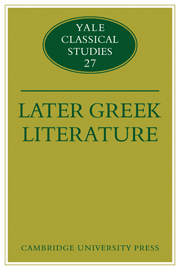Book contents
- Frontmatter
- Contents
- Introduction
- Theme, structure and narrative in Chariton
- The importance of sophists
- Lucian: a sophist's sophist
- The mendacity of Kalasiris and the narrative strategy of Heliodoros' Aithiopika
- The Emperor Julian on his predecessors
- Greek translations of Latin literature in the fourth century A.D.
- The empress and the poet: paganism and politics at the court of Theodosius II
- Pastiche, pleasantry, prudish eroticism: the letters of ‘Aristaenetus’
- The date and purpose of the Philopatris
The date and purpose of the Philopatris
Published online by Cambridge University Press: 06 December 2010
- Frontmatter
- Contents
- Introduction
- Theme, structure and narrative in Chariton
- The importance of sophists
- Lucian: a sophist's sophist
- The mendacity of Kalasiris and the narrative strategy of Heliodoros' Aithiopika
- The Emperor Julian on his predecessors
- Greek translations of Latin literature in the fourth century A.D.
- The empress and the poet: paganism and politics at the court of Theodosius II
- Pastiche, pleasantry, prudish eroticism: the letters of ‘Aristaenetus’
- The date and purpose of the Philopatris
Summary
Of unknown authorship, uncertain date, and debatable purpose, the Philopatris is one of the more curious documents to emanate from later antiquity. Its frequently peculiar language and its attempt to fuse traditional elements of the Platonic-cum-Lucianic dialogue with the newer demands of Christian orthodoxy conspire to make it a work of considerable interest to the student of late Greek literature.
No time need be spent defending Lucian against the charge of writing the Philopatris. Doubts were evinced at least as long ago as the Florentine editio princeps of 1496; they have prevailed ever since. Three considerations rule out the satirist. First, the indifferent Greek, with its faltering syntax and confusion of dialects. Second, much of the piece is a cento of phrases and effects from genuine Lucianic works. Finally, the mention of an ἐξισωτής or peraequator, an official not attested before the reign of Constantine.
The last two of these points are equally fatal to the notion, found occasionally in the older commentators, that the dialogue predates Lucian. It has been assigned to around the time of Nero, on the basis of Triepho's claim (12) to have recently (πρῴην) had an encounter with the apostle Paul. But this is to impart to the dialogue a dramatic realism to which it does not pretend.
- Type
- Chapter
- Information
- Later Greek Literature , pp. 321 - 344Publisher: Cambridge University PressPrint publication year: 1982



